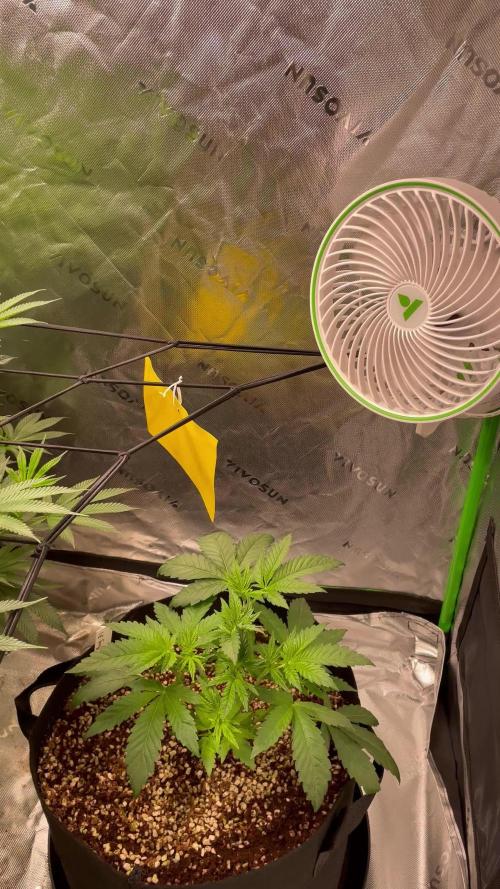The Grow Awards 2026 🏆 































Likes
Comments
Share


@Canaryweed_tf
Follow
Pues ya tenemos la quinta semana de la HellfireOG de Kannabiaseeds, está semana van creciendo muy bien las he abonado con agua con ph de 6,5 y tambien les he echado un fertilizante casero de crecimiento echo por mi
Likes
45
Share


@tresplantes
Follow
Heading into week 4 of Flower everything is budin up really nice
Zake is the frostiest and really has a mint smell to it
Looks like i already can say that breakpad breath will take more than 8 weeks
Pink runtz x Hollywood has a Creazy Sweet smell to it
Likes
5
Share


@Tropical_Growerz
Follow
Hello, the plants are doing well. They are in the last week before harvest. There was good defoliation. I can't wait to see them reach their full potential.
Likes
31
Share


@ProfessorGrow
Follow
Let’s dry at 18C 55% Humidity for 2 weeks!
Finished with 137g after drying and trimming.
Likes
23
Share


@Fatnastyz
Follow
Week 2 flower
Day 1, Day 29 from seed.
Bent her head just a little and removed a few leaf blockers! She got a tent all by herself.
Smellin good now too, only one open stinking up the room! 🤤🤘
10-5
250ml
10-6
1/4 cup poo, 3 tbs buildaflower scoop of connect.
10-7
water, started a tea, 1/4 poo, kelp, yucca, cal/mag, recharge! Tried to keep it simple.
10-8
Day 34
Lovin her tea! Lst and defol, open her up a bit.
Slight defol and used some clips.
Fun with pictures! 😁🤘
10-9
Last day of the week! Her head and another branch took off enough for me to bend it!
Was worried wasn't going to be able to. But we got her! Helped a ton!.
After spacing her out, had to play musical tents!
Water after she sleeps today!
See ya next week! 🤘
Heads pulling up after sleepy time!
Processing
Likes
9
Share


@Kushizlez
Follow
Everything coming along nicely. I’ve discontinued all nutes but will give one more little top dressing to the cheese plant tomorrow then that’s it. Just straight stabilized RO water from here out. The slurricane is just packing on PM like crazy. The cheese has actually stopped the spread for the most part. At harvest I’m going to wash the shit out of the slurricane and cheese with some warm RO water and some h202 to get the majority of it dissolved. Other than that the quality of the slurricane is beyond ridiculous. It’s by far the stickiest strain to the touch in the tent. It’s probably winning for smell too. It’s straight gassy licorice pine. The pm susceptibility is a deal breaking drawback though.
The cheese is looking good and smells great. It almost smells like rotten milk. Some of the nugs are really filling out into these nice long chunky little things. The pistils are turning a light orange/pink color too. Unfortunately it’s not maturing at the same rate and will make everything in the tent go for another 1.5-2 weeks.
Garlics are looking better. The lanky pheno has filled out quite a bit more than expected and is super frosty with a great smell. It’s finally starting to purple up a bit. I think it will still be quite leafy around harvest but time will tell. Pheno 2 has better structure and density but lacks frost, smell and color. Not very impressed by it honestly.
The zkittlez is looking great and getting super frosty. Especially around the crowns of the top colas. Lowers look like shit though. Despite being somewhat leafy, the main branches look quite dense. It’s probably the shortest and bushiest plant in the garden. It’s yellowing out quite a bit now and will probably finish with the blackberries and slurricane.
The blackberries look amazing and smell even better. One of the phenos is a crazy producer and creates massive buds with musky berry terps. The other pheno is a beautiful purple strain that produces a crazy amount of frost and chunky golf ball nugs at the expense of large yield. It’s smell is very sweet and candy like and has been a very low feeding and maintenance plant.
Slurricane #4 looks great aside from its infection. It definitely wins for resin content and smell but looks like a low yielder.
Likes
9
Share


@SzkolaZiola
Follow
Getting there. Not as fat as I'd wish, but very terpy - all smell amazing.
It's week 7.5 now. Probably gonna harvest Purple Majik in a week and the rest in about 10-14 days - they need some more time but are fading fast.
Now they only get pH'd water.
Processing
Likes
5
Share


@GaiaGreenGiant
Follow
New weekly uploads for a glimpse of what’s happening in the Cabbage Patch!
She’s loving life!
Day 38 - Wanted to rid her of some lower growth so I decided to make a lil video. Cheers 🍻
Likes
3
Share


@Budz420
Follow
They loving life so far, bushy and short, topped her and removed some of the big fan leaves.
Love this strain👌🏼, didn't face any issues so far since it's my first grow.
Last week before sending them to flowering, trying to give them some shape, making sure all leaves getting enough light, looking so healthy.
Likes
33
Share


@Ferenc
Follow
Day 57 : 600W LED, 18 hours on 6 hours off light schedule, the same with ventilation. Water intake 200 ml per plant per day, fertilization remains the same on Monday, Wednesday and Friday Biobizz Family and on Tuesday Thursday Saturday bat guano and Epsom salt. Humidity approx 50 %. Smell is strong and nice.
Day 58: I removed all the LST stuff so no more elastic bands and hooks.
Day 62: Plants are developing nicely especially BlackBerry Kush and LSD-25 they will be the fastest.
Likes
50
Share


@Ferenc
Follow
Day 65, 14th of November 2020:
Nice! Topping has stopped her to grow and strech too much which is good she is more chubby type strain so i expect some thickness lol....
Pre flowers and pistils are out so just waiting for the fruit lol ;)
Really nice all good.
Fertilization happens every 2nd day with the ratio and mix above.
I set the lamp 15 minutes shorter to switch off earlier so she receives 11:45 of darkness. I would like to imitate the nature when longer nights come with time till the 4th week (when she will receive 13 hours darkness a day 15 minutes minus 4 times = 1hour) so every week 15 min longer darkness for 4 weeks and then back to 12/12 to have bigger buds from the 4th week....
Likes
19
Share


@GoldenWeedGrower
Follow
Legend
Timestamp: 📅
EC - pH: ⚗️
Temp - Hum: 🌡️
Water: 🌊
Food: 🍗
pH Correction: 💧
Actions: 💼
Thoughts: 🧠
Events: 🚀
Media: 🎬
D: DAY, G: GERMINATION, V: VEGETATIVE, B: BLOOMING, R: RIPENING, D: DRYING, C: CURING
________________________________
📅 D84/B22 - 07/02/24
⚗️ EC: 1 pH: 5.0
🌡️ T: 19-26 °C H: 55-65 %
🌊 8L
🍗 CalMag - Bloom A-B - B52 - Bud Candy - Big Bud
💧
💼
🧠 The VPD rate was stable on the right value for all the day ! Great, and many thanks to TrolMaster Tent-X !
🚀
🎬 Added Timelapse video and screenshots
________________________________
📅 D85/B23 - 08/02/24
⚗️ EC: 0.8 pH: 5.2
🌡️ T: 19- 24 °C H: 45-80 %
🌊 2L
🍗
💧
💼
🧠 I'm lowering down the EC as I see signs of burns on tips
🚀 Humidity went out of control for about 2h
🎬 I made a photoset with "Garlic Puppy" enjoy the pictures 😋. Added Timelapse video and screenshots
________________________________
📅 D86/B24 - 09/02/24
⚗️ EC: 0.8 pH: 5.2
🌡️ T: 20-26 °C H: 50-70 %
🌊
🍗
💧
💼 Little defolation
🧠
🚀
🎬 Added Timelapse video and screenshots
________________________________
📅 D87/B25 - 10/02/24
⚗️ EC: 0.8 pH: 5.2
🌡️ T: 22-24 °C H: 55-65 %
🌊
🍗
💧
💼 Little Defolation
🧠 The buds are forming
🚀 Today VPD was very stable
🎬 Added Timelapse video
________________________________
📅 D88/B26 - 11/02/24
⚗️ EC: 0.7 pH: 5.2
🌡️ T: 20-25 °C H: 50-77 %
🌊
🍗
💧
💼 Little Defolation
🧠
🚀 Humidity went out of control for about 2h
🎬 Added 8 pics of Nicole, the timelapse video and the screenshots
________________________________
📅 D89/B27 - 12/02/24
⚗️ EC: 0.7 pH: 5.5
🌡️ T: 19-25 °C H: 50-70 %
🌊 4L
🍗 CalMag - Bloom A-B - B52 - Bud Candy - Big Bud
💧
💼
🧠
🚀
🎬 Added timelapse video and screenshots
________________________________
📅 D90/B28 - 13/02/24
⚗️ EC: 0.9 pH: 5.8
🌡️ T: 19-25 °C H: 50-70 %
🌊 4L
🍗 CalMag - Bloom A-B - B52 - Bud Candy - Big Bud
💧
💼
🧠
🚀
🎬 Added timelapse video and screenshots
Likes
9
Share


@northsweed
Follow
plants were majorly defoliated and are flowering awesomely! just the small one is showing some deficiencies due to unstable pH
----
mid week update:
i am becoming kind of concerned about buds themselves – they seem rather small at this stage 😳
Likes
4
Share


@Fyno_TH
Follow
Week 7 ✅ — the final week of veg! Main plant is drinking heavy now, taking around 15L with 10–20% runoff. Roots are exploding and the canopy is filling the net perfectly 🌱🔥.
Main plant is wide and strong with a bushy structure from all the topping + LST. The second plant is still smaller but pushing steady new growth and looking healthy 💪.
Feed mix (per L):
• Corex 1.5 g/L
• Eldex 2 g/L
• Terra 0.4 g/L
• CalMag 1.3 ml/L
• Mira 0.5 ml/L (pH adjust)
• Bud Candy 2 ml/L
• Terpinator 5 ml/gal (~1.3 ml/L)
Ppm around 1400 @ pH 6.0. With 15L per plant and proper runoff, coco is staying clean and roots are thriving.
Environment has been consistent: 26–27 °C / RH 60–65%. Leaves are praying strong under the Spider Farmer G3000, no burn, no deficiency 🌬️🌿.
Likes
7
Share


@Messypies
Follow
2/3 plants doing good. 1 plant however has a calcium defficiency showing as orange spots on 2 of the fan leaves.i have added 2 ml of cal mag in with their new nutrient feeds to help offset.
I have been watering normally without nutes for the first 3-4 weeks. The defficiency has resulted from me using soft tap water which contains very little calcium.
Since adding, no new spots have appeared so fingers crossed
Only using half reccomended dose of nutrients at this point to ease them In to feeding
Likes
27
Share


@LockDownGrow
Follow
well this lady has been a gem too work with , she really stretched out at flower growing from a rose into too a sun flower lol but not quiet as tall as her sister the cali snow ,
she has been no trouble at all so far no deficiency's at all , also her bud structure is forming nicely and again not too far behind the cali snow ,
but both plants have almost identical structures too each other until you rub your fingers on those sugar leaves and they tell you they are doing there own thing by the lush sent they leave you sniffing your fingers in delight , the cali snow has much more of a friuty smell than the GSC but they both smell delicious thats for sure


























